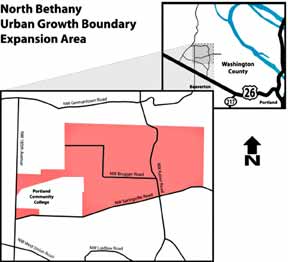Transportation planning in the northern
Tualatin Valley
By Virginia Bruce
It’s probably too late to sort out the mess that is the road network
in Cedar Mill. The roads were built to serve the loggers and farmers that
first settled the area, following native trails and winding around farm
properties to get goods to Portland and Beaverton. When the area began
to be more heavily developed in the 50s and 60s, there was no money or
strong vision from the County to create a transportation infrastructure
adequate to serve future needs. So we’re left with attempts to make
things work a little better—expanding Cornell, Murray and Saltzman
to alleviate some of the congestion and improving intersections to speed
up traffic.
Public transportation is seriously lacking in our area, and there are
many reasons. Lack of a grid with convenient loops for buses means that
bus service is minimal. Spread-out neighborhoods invite residents to use
their cars for every trip. People who wish to rely on public transportation
simply don’t move here, and so there’s little demand from the
public to improve the situation.
The MAX light rail system was eagerly anticipated as a way to assist
commuters in leaving their cars behind, but now the garage is filled before
8 am on weekdays, so most commuters aren’t able to use it. According
to TriMet, there wasn’t enough money available to build a sturdy
enough foundation to accommodate additional floors to the garage. And the
Cedar Mill Shuttle, while well-intentioned, serves only a tiny handful
of potential commuters.
 North Bethany offers hope North Bethany offers hope
Planning for the area called North Bethany, the 800-acre Urban Growth
Boundary expansion around the PCC Rock Creek campus, is just getting underway
in earnest. Many Cedar Mill residents fear that more people to the north
will only mean more congestion for us, as the new residents make their
way from Highways 26 and 17 to their new homes. Is there a way to actually
plan for adequate routes to get these people in and out?
Metro Planning Director Andy Costugno thinks so. He says, “I think
a “Main Street” type corridor makes sense (for North Bethany)—a
very high quality bus route with land uses along it that support easy access
to transit and a few sections along the way that are like a Main Street
with commercial and mixed-use. Then bus service could be incrementally
improved as ridership develops. If a median right-of-way were retained,
it could be used for Light Rail or a streetcar at some time in the future.
If it never develops, it could simply be an attractive boulevard.”
Visionary thinking like that could at least help to handle the transportation
needs of future residents. Andrea Vanelli, who is coordinating project
administration for Washington County in the Bethany planning process, says, “So
far the planning work has been somewhat preliminary—necessary things
like providing analysis of existing conditions and early estimates of future
needs. The next steps begin some of the more interesting work of compiling
all of this site information to begin to see how it may take shape. The
early months of ‘07 will include an iterative land use-transportation
analysis whereby the various components inform and shape different alternatives
for consideration.”
“So the transportation piece of the work will be at a rather “sketch” level
for a while, however the group’s evaluations will be guided by a
set of Planning Principles that describe the desire for transportation
options that are well-integrated with community design. A planner with
Tri-Met is following this work on the project Technical Advisory Committee,
and we are relying upon him to help explore far-sighted concepts such as
the one Andy mentions regarding a boulevard with a convertible median for
future streetcar use.”
“As for the larger transportation picture, it’s obvious there
will be a need for new arterials as part of this growth, and we are coordinating
with Multnomah County and Metro’s Regional Transportation Plan update
as part of the planning process.”
Light rail is very expensive. The Green Line that will follow I-205,
for example, is expected to cost at least $450 million, and 60% of
that is coming from Federal funds, which is much less available these days.
So grandiose projects like a new MAX line are currently out of the
question. But things can change, and it would be a shame to eliminate the
possibility of good transportation in and out of North Bethany by failing
to plan for it now.
|
